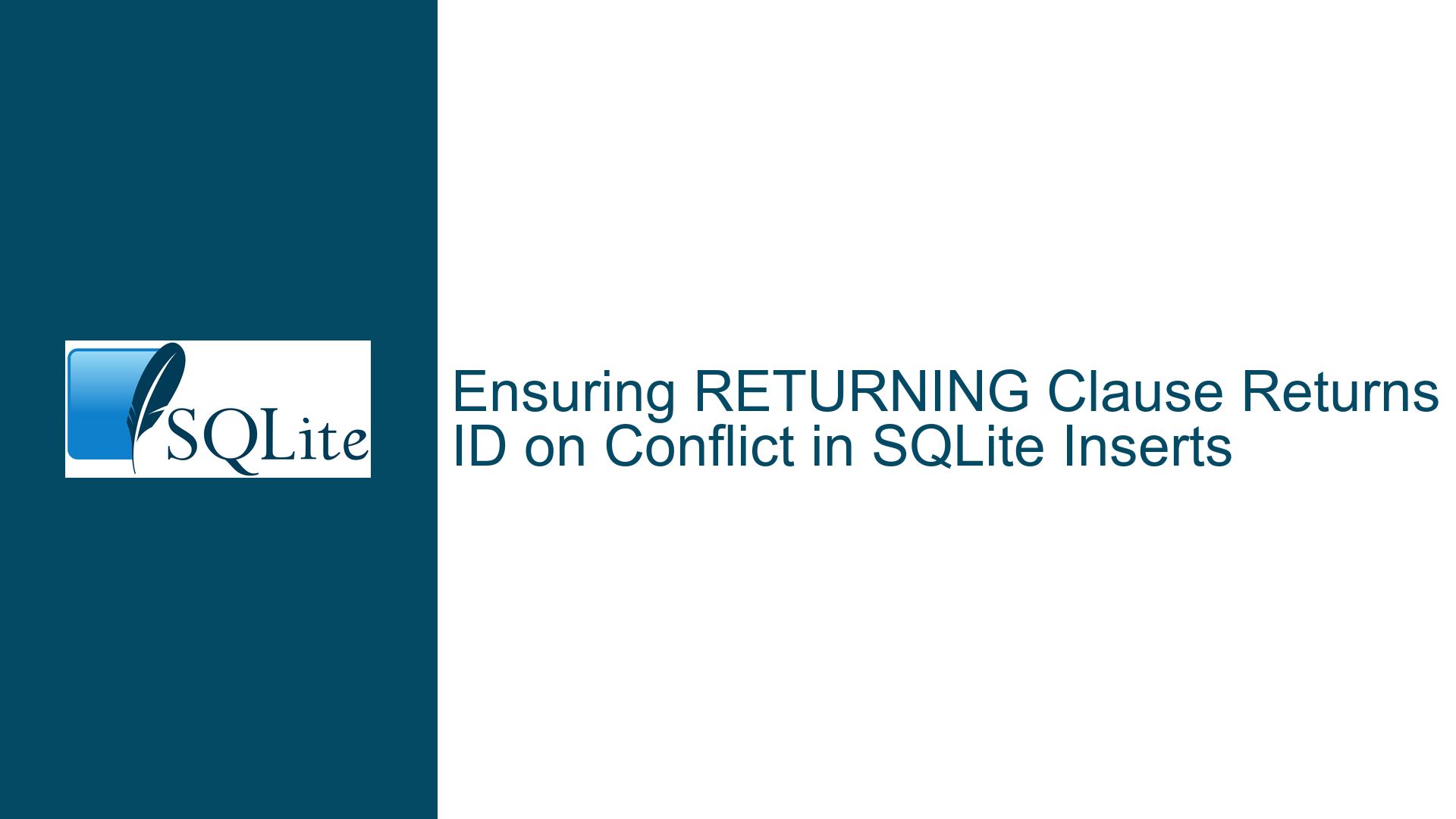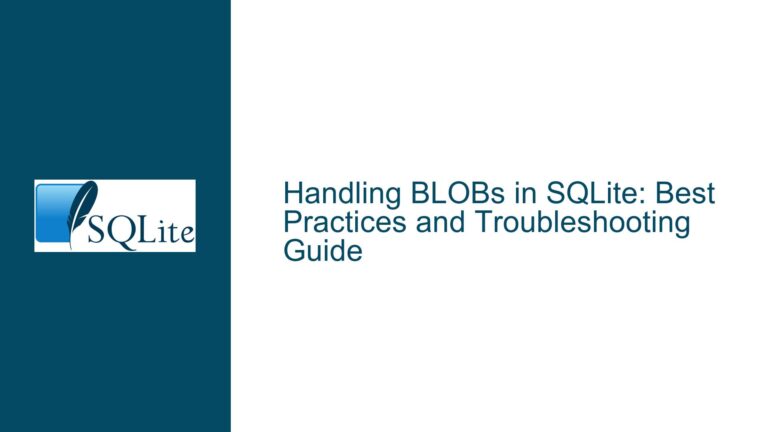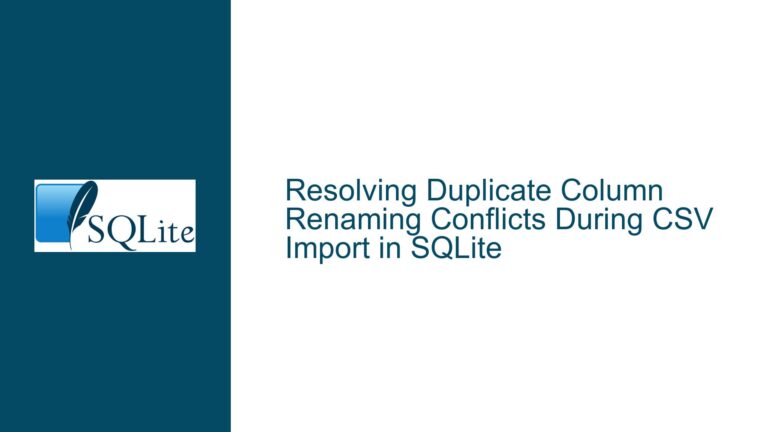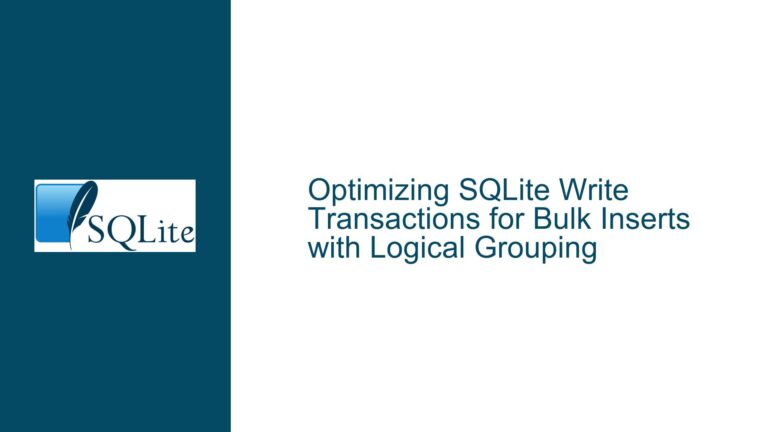Ensuring RETURNING Clause Returns ID on Conflict in SQLite Inserts
Understanding the Idempotent Insert Requirement with Consistent ID Retrieval
The core challenge revolves around implementing an idempotent insertion mechanism in SQLite where the RETURNING clause consistently provides the id of a row, regardless of whether the insertion succeeded or was skipped due to a uniqueness constraint violation. This behavior is critical for applications requiring deterministic outcomes without additional round-trips to the database. The problem arises from SQLite’s handling of INSERT ... ON CONFLICT DO NOTHING combined with RETURNING, which omits results when no insertion occurs. Below, we dissect the issue, explore underlying causes, and present actionable solutions.
Mechanism of SQLite’s ON CONFLICT and RETURNING Interactions
Primary Issue: Absence of RETURNING Data on Conflict Resolution
When using INSERT INTO ... ON CONFLICT DO NOTHING RETURNING id, SQLite’s RETURNING clause only produces output if the insertion proceeds without conflict. If a uniqueness constraint violation occurs (e.g., duplicate name in the tag table), the DO NOTHING directive suppresses the error but skips the insertion. Consequently, no row is modified, and RETURNING has nothing to output. This leaves the application without the id of the existing row, necessitating a follow-up SELECT query.
Behavioral Constraints in SQLite vs. PostgreSQL
In PostgreSQL, Common Table Expressions (CTEs) allow combining conditional inserts with subsequent selects in a single statement. SQLite, however, prohibits INSERT within CTEs used in this manner, forcing developers to seek alternative approaches. Additionally, SQLite’s last_insert_rowid() function is tied to the most recent successful insertion, rendering it ineffective when conflicts occur.
Impact of DO UPDATE as a Workaround
A suggested workaround involves using ON CONFLICT DO UPDATE with a no-operation update (e.g., SET name = excluded.name). While this forces the RETURNING clause to execute, it triggers an unnecessary write operation. Even if the updated value matches the existing one, SQLite’s write-ahead logging (WAL) or journaling mechanisms will log the change, incurring disk I/O. This raises concerns about performance degradation in high-throughput scenarios.
Root Causes of the Idempotent Insertion Challenge
Limitations of ON CONFLICT DO NOTHING Semantics
SQLite’sON CONFLICTclause is designed to handle constraint violations by either ignoring the conflict (DO NOTHING) or merging data (DO UPDATE). TheRETURNINGclause, however, is intrinsically tied to the success of theINSERTorUPDATEoperation. WhenDO NOTHINGis invoked, no mutation occurs, leavingRETURNINGwith no data to emit. This design aligns with SQLite’s minimalist philosophy but complicates idempotent workflows.Transactional Atomicity Without Multi-Statement Guarantees
SQLite ensures atomicity at the transaction level but does not provide atomicity across multiple standalone statements. To retrieve theidafter a failed insertion, a separateSELECTis required. Without wrapping both operations in a transaction, race conditions may arise if concurrent processes modify the table between theINSERTandSELECT.Inapplicability of last_insert_rowid()
Thelast_insert_rowid()function reflects the row ID of the most recent successful insertion within the same database connection. If the insertion is skipped due to a conflict, this function returns the ID of the last prior insertion, leading to incorrect results. This makes it unsuitable for scenarios requiring deterministic ID retrieval.Absence of Built-in Upsert-Returning Feature
Unlike PostgreSQL’sON CONFLICT ... RETURNING, SQLite lacks a native mechanism to return existing row data when an insertion is skipped. This gap necessitates workarounds that either force updates or require secondary queries.
Strategies for Reliable ID Retrieval in Idempotent Inserts
Solution 1: Forced Update with ON CONFLICT DO UPDATE
Modify the ON CONFLICT clause to perform a benign update, ensuring RETURNING always fires:
INSERT INTO tag (name)
VALUES ('example')
ON CONFLICT (name) DO UPDATE SET name = excluded.name
RETURNING id;
How It Works:
- If the
nameis new, the insertion proceeds, andRETURNINGprovides the newid. - If the
nameexists, theDO UPDATEsetsnameto its current value (a no-op change). SQLite treats this as an update, triggeringRETURNINGto output the existingid.
Trade-offs:
- Disk I/O Overhead: Even no-op updates write to the transaction log. For tables with high write concurrency, this may increase lock contention.
- Trigger Side Effects: Any
AFTER UPDATEtriggers will execute, potentially introducing unintended behavior.
Optimization Consideration:
Add a dedicated updated_at column to make the update operation meaningful:
INSERT INTO tag (name, updated_at)
VALUES ('example', CURRENT_TIMESTAMP)
ON CONFLICT (name) DO UPDATE SET updated_at = CURRENT_TIMESTAMP
RETURNING id;
This approach leverages the update to track modification times while ensuring RETURNING functionality.
Solution 2: Post-Insert SELECT Within a Transaction
Wrap the insertion attempt and subsequent select in an explicit transaction to guarantee atomicity:
BEGIN TRANSACTION;
INSERT INTO tag (name) VALUES ('example') ON CONFLICT DO NOTHING;
SELECT id FROM tag WHERE name = 'example';
COMMIT;
Advantages:
- Avoids unnecessary writes and trigger activations.
- Simplifies logic by separating insertion from retrieval.
Caveats:
- Requires handling transactions at the application level.
- Slightly higher latency due to two round-trips (mitigated by transaction bundling).
Isolation Considerations:
SQLite’s default isolation level (SERIALIZABLE) ensures that concurrent transactions cannot interfere with the INSERT-SELECT sequence, provided both operations occur within the same transaction.
Solution 3: Hybrid Approach with EXISTS Check
Combine an existence check with conditional insertion, though this is less efficient due to dual checks:
INSERT INTO tag (name)
SELECT 'example'
WHERE NOT EXISTS (SELECT 1 FROM tag WHERE name = 'example');
SELECT id FROM tag WHERE name = 'example';
Pitfalls:
- The
SELECTstatement may return multiple rows if concurrent inserts occur between theINSERTandSELECT. - Not atomic unless wrapped in a transaction.
Solution 4: Leveraging Temporary Tables or Triggers (Advanced)
For frequent operations, create a temporary table to store the target name and join it with the main table:
WITH input(name) AS (VALUES ('example'))
INSERT INTO tag (name)
SELECT name FROM input
WHERE NOT EXISTS (SELECT 1 FROM tag WHERE tag.name = input.name)
RETURNING id;
If no rows are returned, execute:
SELECT id FROM tag WHERE name = 'example';
This requires application logic to handle both cases but minimizes redundant updates.
Decision Matrix for Solution Selection
| Solution | Atomic | Writes | Trigger Execution | Complexity |
|---|---|---|---|---|
| Forced Update | Yes | Yes | Yes | Low |
| Transaction + SELECT | Yes | No | No | Medium |
| EXISTS Check | No | No | No | High |
| Temporary Tables/Triggers | Partial | Depends | Depends | High |
Recommendation:
For most applications, Solution 1 (Forced Update) strikes a balance between simplicity and reliability, provided disk I/O and trigger side effects are acceptable. For write-sensitive workloads, Solution 2 (Transaction + SELECT) is preferable, albeit with slightly more complex application logic.
Addressing Edge Cases and Performance Considerations
Concurrent Inserts
Ensure transactions are used to prevent race conditions. SQLite’s lock-based concurrency control serializes write operations, guaranteeing that only one transaction modifies the database at a time.Indexing and Write Amplification
Thenamecolumn’s unique index is essential for conflict detection but adds overhead during inserts. Forced updates may marginally increase write amplification, impacting performance on low-end hardware.Bulk Insertions
Batch insertions usingINSERT ... VALUES (...), (...), ...withON CONFLICT DO UPDATEcan streamline bulk operations, but test for scalability as transaction logs grow.
Conclusion
Achieving idempotent inserts with consistent id retrieval in SQLite requires circumventing the RETURNING clause’s limitation during conflicts. By either forcing benign updates or coupling inserts with transactional selects, developers can ensure reliable outcomes. While each approach carries trade-offs, understanding the underlying mechanics empowers informed decisions tailored to specific application needs. Future SQLite enhancements may introduce more elegant solutions, but current methodologies remain robust and effective.






